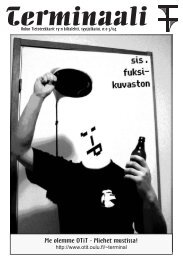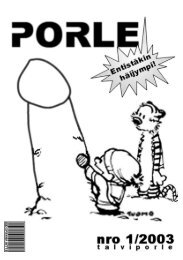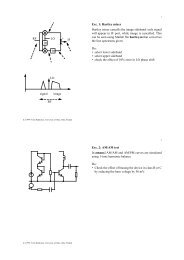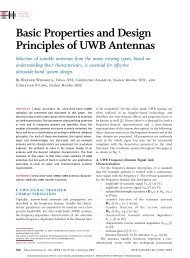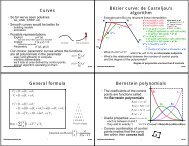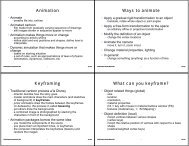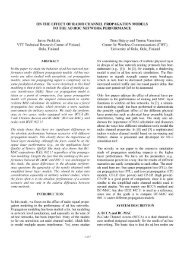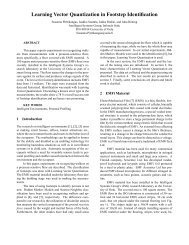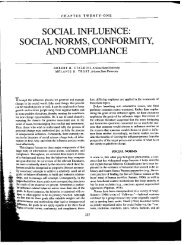Accurate, Dense, and Robust Multiview Stereopsis - Department of ...
Accurate, Dense, and Robust Multiview Stereopsis - Department of ...
Accurate, Dense, and Robust Multiview Stereopsis - Department of ...
You also want an ePaper? Increase the reach of your titles
YUMPU automatically turns print PDFs into web optimized ePapers that Google loves.
1368 IEEE TRANSACTIONS ON PATTERN ANALYSIS AND MACHINE INTELLIGENCE, VOL. 32, NO. 8, AUGUST 2010<br />
where the weights wðpÞ are Gaussian functions <strong>of</strong> the<br />
distance between cðpÞ <strong>and</strong> the line, with st<strong>and</strong>ard<br />
deviation 1 defined as in Section 3.2.1, <strong>and</strong> normalized<br />
to sum to 1. 8 We iterate until convergence, while applying<br />
remeshing operations (edge split, contract, <strong>and</strong> swap [30])<br />
to avoid self-intersections once every five gradient descent<br />
steps so that the edge lengths <strong>of</strong> the triangles on a mesh<br />
become approximately the same. After convergence, we<br />
increase the resolution <strong>of</strong> the mesh <strong>and</strong> repeat the process<br />
until the desired resolution is obtained, in particular, until<br />
image projections <strong>of</strong> edges <strong>of</strong> the mesh become approximately<br />
1 pixels in length.<br />
4.2 Mesh Refinement<br />
The mesh refinement is performed via an energy minimization<br />
approach similar to our iterative snapping<br />
procedure described in Section 4.1.2: The 3D coordinates<br />
<strong>of</strong> all <strong>of</strong> the vertices are optimized with respect to a sum <strong>of</strong><br />
per-vertex photometric discrepancy <strong>and</strong> geometric smoothness<br />
energy functions. The smoothness function is the same<br />
as before (9). The photometric discrepancy energy is<br />
computed in the following two steps: 1) The depth <strong>and</strong><br />
the orientation <strong>of</strong> a surface are estimated at each vertex<br />
independently for each pair <strong>of</strong> its visible images by using<br />
the patch optimization procedure; 2) the estimated depth<br />
<strong>and</strong> orientation information are combined to compute the<br />
energy function. More concretely, let V ðviÞ denotes a set <strong>of</strong><br />
images in which vi is visible that is estimated from a<br />
st<strong>and</strong>ard depth-map test with a current mesh model. In the<br />
first step, for each pair ðIj;IkÞ <strong>of</strong> images in V ðviÞ, we create<br />
a patch p on the tangent plane <strong>of</strong> the mesh at vi, namely,<br />
setting cðpÞ cðviÞ <strong>and</strong> nðpÞ nðviÞ, then minimize the<br />
photometric discrepancy function hðp; Ij;IkÞ with respect to<br />
cðpÞ <strong>and</strong> nðpÞ as in Section 2.3. 9 Having obtained a set <strong>of</strong><br />
patches PðviÞ after the patch optimization for pairs <strong>of</strong><br />
images, the photometric discrepancy energy is computed as<br />
the sum <strong>of</strong> one minus (scaled) Gaussian function <strong>of</strong> the<br />
distance between each patch <strong>and</strong> the vertex:<br />
X<br />
E 0 pðviÞ ¼ 3<br />
p2P ðviÞ<br />
1 exp<br />
d 0 ðvi;pÞ¼nðpÞ ðcðpÞ viÞ:<br />
d 0 ðvi;pÞ<br />
=4<br />
!<br />
2<br />
;<br />
ð11Þ<br />
d 0 ðvi;pÞ is the (signed) distance between the patch p <strong>and</strong> the<br />
vertex vi along the patch normal, is the average edge<br />
length <strong>of</strong> the mesh, <strong>and</strong> 3 is the linear combination weight.<br />
Note that we borrow the idea <strong>of</strong> occlusion robust photoconsistency<br />
proposed in [31], <strong>and</strong> first obtain multiple<br />
estimates <strong>of</strong> the depth <strong>and</strong> the orientation from pairs <strong>of</strong><br />
visible images, instead <strong>of</strong> using all <strong>of</strong> the visible images at<br />
once to obtain a single estimate. Then, in the second step,<br />
multiple estimates are combined with Gaussian functions<br />
that are robust to outliers. Also note that the patches PðviÞ<br />
are computed only once at the beginning as preprocessing<br />
for each vertex, while the photometric discrepancy energy<br />
(11) is evaluated many times in the energy minimization<br />
8. EpðviÞ has a form <strong>of</strong> the Huber function so that the magnitude <strong>of</strong> its<br />
derivative does not become too large in each gradient descent step to ensure<br />
stable deformation <strong>and</strong> avoid mesh self-intersections.<br />
9. During the optimization, the patch center cðpÞ is constrained to lie on a<br />
ray passing through vi in parallel to nðviÞ.<br />
Fig. 9. (a) Pairwise photometric discrepancy scores hðp; Ii;IjÞ at a<br />
vertex <strong>of</strong> temple data set. For better illustration, among three degrees <strong>of</strong><br />
freedom in the optimization (a depth <strong>and</strong> a normal), the discrepancy<br />
scores are plotted for different values <strong>of</strong> depths with a fixed normal. A<br />
triangle on each plot illustrates the location <strong>of</strong> a local minimum that is a<br />
depth value obtained from the patch optimization procedure for a pair <strong>of</strong><br />
images. (b) The sum <strong>of</strong> all <strong>of</strong> the pairwise discrepancy scores giving an<br />
inaccurate local minimum location <strong>and</strong> our proposed photometric<br />
discrepancy energy (11). (c) An input image <strong>of</strong> temple with a red circle<br />
illustrating the location <strong>of</strong> the vertex.<br />
procedure performed by a conjugate gradient method [28].<br />
Fig. 9 illustrates how this refined photometric discrepancy<br />
energy h<strong>and</strong>les outliers, or “bad” images <strong>and</strong> patches<br />
robustly <strong>and</strong> avoids false local minima. Although the<br />
fundamental idea has not changed from [31], there are a<br />
couple <strong>of</strong> differences worth mentioning. First, in addition to<br />
a depth value, a surface normal is incorporated in our<br />
framework, both in the patch optimization step <strong>and</strong> in the<br />
final formula (11). Second, we use a Gaussian (kernel)<br />
function to combine multiple hypothesis (patches) (11),<br />
while a box function is chosen in [31] with discretized<br />
voxels, which ends up simply casting votes to voxels.<br />
5 EXPERIMENTS AND DISCUSSION<br />
5.1 Data Sets<br />
Fig. 10 shows sample input images <strong>of</strong> all <strong>of</strong> the data sets<br />
used in our experiments. Table 1 lists the number <strong>of</strong> input<br />
images, their approximate size, the corresponding choice <strong>of</strong><br />
parameters, the algorithm used to initialize a mesh model<br />
(either PSR s<strong>of</strong>tware [29] or iterative snapping after visual<br />
hull construction, denoted as VH), <strong>and</strong> whether images<br />
contain obstacles (crowded scenes) or not. Note that all <strong>of</strong><br />
the parameters except for , , <strong>and</strong> 3 have been fixed in our<br />
experiments. The roman <strong>and</strong> skull data sets have been<br />
acquired in our lab, while other data sets have been kindly<br />
provided by S. Seitz, B. Curless, J. Diebel, D. Scharstein, <strong>and</strong><br />
R. Szeliski (temple <strong>and</strong> dino, see also [2]), S. Sullivan <strong>and</strong><br />
Industrial Light <strong>and</strong> Magic (face, face-2, body, steps-1, <strong>and</strong><br />
wall), <strong>and</strong> C. Strecha (fountain, city-hall, brussels, <strong>and</strong> castle).<br />
The steps-2 data set has been artificially generated by<br />
manually painting a red cartoonish human in each image <strong>of</strong><br />
steps-1 images. To further test the robustness <strong>of</strong> our<br />
algorithm against outliers, the steps-3 data set has been<br />
created from steps-2 by replacing the fifth image with the<br />
third, without changing camera parameters. This is a<br />
particularly challenging example since the entire fifth image<br />
must be detected as an outlier.




